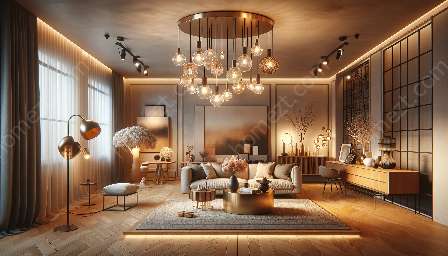Lighting for architectural features is an essential element in the overall design of any space, whether it’s a residential or commercial property. It plays a significant role in highlighting the aesthetic appeal and functionality of architectural features, contributing to the overall ambiance and visual impact. In this comprehensive guide, we will delve into the transformative power of lighting for architectural features, providing insights into various lighting fixtures and installation techniques to enhance your home's interior decor.
Understanding the Importance of Lighting for Architectural Features
Architectural features, such as vaulted ceilings, arched doorways, accent walls, and intricate moldings, define the character and uniqueness of a space. However, without proper illumination, these features may go unnoticed or fail to make the desired visual impact. Lighting for architectural features aims to bring focus and attention to these elements, allowing them to stand out and contribute to the overall design narrative.
Enhancing Visual Appeal
The strategic use of lighting can enhance the visual appeal of architectural features by creating a sense of depth, texture, and drama. For example, uplighting can emphasize the height of a vaulted ceiling, while wall-washing techniques can accentuate the texture of a stone accent wall. By illuminating these features, lighting adds a layer of sophistication and visual interest to the space.
Improving Functionality
Effective lighting design not only enhances the aesthetics of architectural features but also improves the functionality of the space. Properly lit architectural elements can contribute to a more inviting and comfortable environment, guiding the flow of movement and creating a sense of balance and harmony within the space.
Choosing the Right Lighting Fixtures for Architectural Features
When it comes to selecting lighting fixtures for architectural features, it is essential to consider the design style, scale of the space, and the specific features that need to be highlighted. Here are some popular lighting fixtures that are commonly used to accentuate architectural features:
- Recessed Lighting: Ideal for highlighting specific architectural elements, recessed lighting provides a clean and contemporary look while seamlessly integrating into the ceiling, walls, or floors.
- Wall Sconces: These fixtures are perfect for illuminating accent walls, alcoves, or architectural details, adding visual interest and a warm ambiance to the space.
- Track Lighting: Offering flexibility and directional control, track lighting is suitable for emphasizing multiple architectural features within the same space, allowing for adjustable illumination.
- Chandeliers and Pendants: These statement fixtures can be used to draw attention to grand architectural features, such as a grand staircase or a high ceiling, while adding a touch of elegance and luxury to the space.
It is important to consider the scale, proportion, and visual impact of the lighting fixtures in relation to the architectural features to achieve a cohesive and harmonious design.
Installation Techniques for Effective Lighting
Proper installation of lighting fixtures is crucial to ensure that architectural features are illuminated effectively. Here are some key techniques for installation:
- Layered Lighting: Implementing a layered lighting design, which includes ambient, task, and accent lighting, can effectively highlight architectural features while providing overall illumination for the space.
- Dimmer Controls: Installing dimmer switches allows for adjustable lighting levels, enabling the flexibility to create different moods and highlight architectural features as desired.
- Concealed Wiring: Concealing wiring and fixtures within architectural elements, such as coves, valances, or recesses, can create a seamless and unobtrusive lighting effect.
Each installation technique should be carefully tailored to the specific architectural features and the overall design concept of the space.
Elevating Interior Decor with Lighting
Integrating the right lighting fixtures and techniques can significantly elevate the interior decor of a home. Lighting not only enhances the architectural features but also contributes to the overall ambiance and functionality of the space. Here are some ways in which lighting can enhance homemaking and interior decor:
- Creating Focal Points: Well-placed lighting can create focal points within a space, drawing attention to specific features or areas and enhancing the overall decor.
- Setting the Mood: Lighting plays a crucial role in setting the mood and ambiance of a room, whether it's creating a cozy atmosphere in the living room or providing task lighting in the kitchen.
- Highlighting Art and Design Elements: Strategic lighting can be used to showcase artwork, decorative objects, and design elements, adding depth and visual interest to the interior decor.
By understanding the impact of lighting on interior decor, homeowners can make informed decisions to enhance the aesthetic and functional aspects of their living spaces.
Conclusion
Lighting for architectural features is a fundamental aspect of interior design, as it contributes to the visual impact, functionality, and overall ambiance of a space. By understanding the importance of lighting, choosing the right fixtures, implementing effective installation techniques, and integrating lighting into interior decor, homeowners can elevate the design potential of their homes and create a truly captivating living environment.


